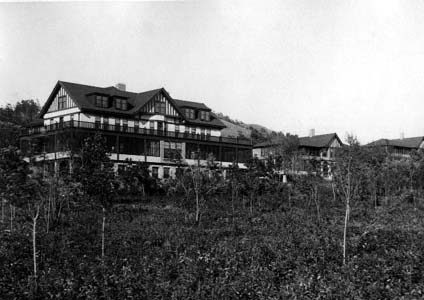Search | Image Archive | Reference | Communities | POV | Lesson Plans | Credits
 Until the development of antibiotics in the 1940s, tuberculosis was the world's number one killer. In the last decade of the nineteenth century, it was discovered that TB was a communicable disease, caused by a bacterium rather then a hereditary disease, as had been previously suspected. With this new knowledge, efforts were redoubled to discover means of prevention and cure.
Until the development of antibiotics in the 1940s, tuberculosis was the world's number one killer. In the last decade of the nineteenth century, it was discovered that TB was a communicable disease, caused by a bacterium rather then a hereditary disease, as had been previously suspected. With this new knowledge, efforts were redoubled to discover means of prevention and cure.
In 1908 the Manitoba Tuberculosis Society began to raise funds to construct a sanatorium, or tuberculosis hospital. With a substantial grant from the province of Manitoba, a sanatorium was built on Pelican Lake, near the village of Ninette. The Manitoba Sanatorium opened in the spring of 1910 as a provincially administered facility with sixty-five beds. Dr. David A. Stewart was appointed Medical Superintendent of what was at that time the only such facility in Western Canada.
Although the Ninette Sanatorium was to gain renown on the 1920s for its public education and outreach programs designed to prevent the spread of the disease, in the early years there was neither time nor money for other than the treatment of those already afflicted. Many of those who fell victim to tuberculosis came from the squalid and overcrowded slums of the city, where poor sanitary conditions, poor nutrition and overwork left many of Manitoba's poor vulnerable. Even more came from aboriginal communities, which faced similar problems of poverty, poor nutrition and poor sanitation. Aboriginals faced the added problem that they lacked any immunity to diseases of European origin.
Before antibiotics, the only way to fight TB was to allow patients to build their natural resistance to the disease. The most effective approach was the "rest cure." When a patient was placed on the rest cure, (s)he was confined to a bed or reclined chair virtually all day. Constant rest was combined with a rich diet and plenty of fresh air.
The rest cure was time-consuming and expensive, and was out of reach of most Manitoba families. Stewart, however, managed to persuade the provincial government of the importance of arresting the spread of TB, and convinced the government to provide subsidies to patients so that they could complete their treatments. In this way, fewer patients left the facility in a condition where they would run the risk of infecting others.
During the First World War, thousands of soldiers weakened by the harsh conditions at the front contracted tuberculosis. Others had been exposed to gas in the trenches and needed specialized lung care. In response to these needs, three new ward buildings, and a training school for nurses were added to the facility.
Page revised: 27 August 2009